
The Beginning
While CanadianRacer.com previously covered CNE Speedway's short-lived rebirth in 1990, the real glory years of racing at Exhibition Stadium were from 1952 to 1966. Massive crowds, up to nineteen thousand fans, were on hand to see the stars of the era.
Fred Hamilton headed the group that was awarded the contract by the City Parks Committee to run stock car racing at the CNE. This created some controversy as the contract was never tendered.
The original track was surfaced with cinder and was 1/3 mile long. The Exhibition Stock Car Racing Association was the group that ran the races which ran on Tuesday and Friday nights. Harley Morden was the Race Director. The drivers were all members of the Canadian Stock Car Racing Club. Admission cost for fans in that first season was $1.00 for adults and 50 cents for children. Purses were paid as a percentage of the paid attendance. The highest winner payout in the 1952 season was $900.
1952
The opening night of racing was April 22, 1952. It was a cold, rainy night but 7,981 fans showed up. The rain didn't stop the racing though. Since the grandstands were covered, the CNE raced rain or shine. In the early years, the race program consisted of eight races: three heat races, a novice race, a consolation race, two semi-finals and the feature. Tom Forbes of Islington won the first feature at the new CNE Speedway.
Attendance reached its peak for the July 1 50 lapper when a capacity crowd of 19,616 was on hand and the promoters had to turn some fans away.
The Midgets made an appearance on July 5, 1952 with Vern Herriman winning the 25 lap feature. The night also featured a three-lap race between Norm Brioux and Ted Hogan who were trying Midgets for the first time.
Buffalo-based promoter Ed Otto brought the NASCAR Late Models to the CNE on July 31, 1952. This was not the Grand National Division (i.e. Winston Cup / Nextel Cup, etc) but a short track series that had many of the stars of the GN Series. The race was 300 laps (100 miles) and was open to 1949-52 cars. Lee Petty won the race by three laps over Ray Duhig in second and Pappy Hough in third. Canadians Norm Brioux, Lloyd Shaw and Ralph Spencer finished tenth through twelth respectively. Len Hurley was the other Canadian in the race. Brioux would have finished even higher but he spent 10 minutes in the pits with spark plug problems.
Racing shut down after the NASCAR event in order to make room for the annual Canadian National Exhibition. When the racing returned on September 12, the track had been paved at a cost of $13,000. Lap speeds increased dramatically (about two seconds) which caused more serious accidents. It was now common for cars to smash right through the wooden fence.
The Midgets returned on September 20 for their second event of the 1952 season with Roy Graham winning the 28 lap feature.
The 1952 season wrapped up on Oct 13 with a 70 lap feature won by Ted Race. Total attendance for the season was near 400,000. Norm Brioux was the first winner of the Molson Trophy as CNE Points Champion.
1953
In January of 1953, Fred Hamilton approached the Parks Committee with a proposal to race on Sunday afternoons in the fall. The application was rejected by City Council in February.
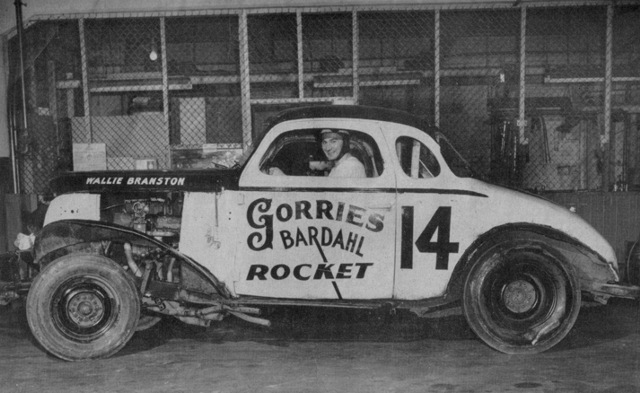
The NASCAR
Late Models made the first of two 1953 appearances on July 21, 1953.
The 250 lap race was won by Bob Welborn. Andy Winfree was second
and Jim Reed was third. The top finishing Canadians were Ivan Boone
and Phil Major who finished eighth and ninth respectively. Other
Canadians in the race were Wallie Branston, Ted Gilbert, Len Hurley,
Ralph Spencer and Mel Littlejohn. The
total purse was $4000 with $750 going to Welborn.
The second visit for the NASCAR Late Models was on September 29
for another 250 lap feature. Canadian Norm Brioux had the fastest car
but two cut tires kept him out of the lead. Bob Welborn won the
race over Jim Reed in second and Virgil Stockton in third. Brioux
ended up fifth.
The 1953 season closed out on Oct 12, Thanksgiving with a 75 lapper.
Wallie Branston won 9 features in 1953 but the points battle was
between Ben Lalomia, Ted Race and Norm Brioux with Lalomia coming
out on top as points champion.
Tommy
McClure was named Race Director in the off-season between 1953 and
1954.
He replaced Harley Morden who was focusing
on Speedway Park, north of Toronto.
The
stars of the first few years included Wallie Branston, Norm Broiux,
Ted Hogan, Ted Race, Ralph Spencer, Ben Lalomia, Tony Occhino, Hugh
Darragh, George Bowers, Len Hurley and Jimmy Howard.
1954
The engine rules were opened up for 1954.
There had been a 300 cubic inch limit in the first two seasons but
for 1954 the cubic inch limit was removed. Overhead cams were still
prohibited. The 1954 opener was April 16. It was a cold
and rainy day but the crowd was 10,362.
The question
of Sunday racing was raised again in the spring of 1954, but again
the idea was shot down by City Council.
Starter
Ross Kennedy barely escaped death on July 9, 1954 when was hit by the race car
driven by Phil Major. Major and Duncan Mayo collided coming out
of turn 4, causing Major's car to spin into the infield. Kennedy
saw it coming and tried to jump onto the stage in the infield. The
impact threw Kennedy 25 feet in the air and he landed 35 feet away
on the platform. He suffered a broken arm, broken shoulder and two
broken ribs. Kennedy always worked down on the track, despite the
fact that there was a traditional, elevated starter's stand.
The NASCAR Late
Models returned on July 20, 1954 for a 250 lap feature. Jim Reed
won by 7 laps over second place finisher Bob Welborn. The night
also included the regular CNE racers.
Ted Hogan had been the points leader throughout
the early part of the 1954 season. George Bowers eventually overtook
him and was the points leader when the racing took a break to make
room for the Canadian National Exhibition. The drivers held a meeting
on the evening of August 2 and decided to race at Speedway Park
on Highway 7 on Tuesday and Friday nights while the CNE was being
held. It appears that they only raced on Fridays though.
The
racers returned after the CNE to finish out the 1954 season in late
September and early October. George Bowers held on to win the Bradings
Points Championship and $650. Ben Lalomia of Buffalo won the the
75-lap Fall Championship to end the season on October 11.
1955
During the off-season
between 1954 and 1955, yet another attempt was made to introduce
Sunday afternoon racing. The Parks Committee voted in favour of
two Sunday afternoon shows on a trial basis with the proceeds going
to charity. The controversy continued throughout the spring. In
June, the request was withdrawn by the CNE promoters.
A pre-season
practice session was held on April 2, 1955 and over 3000 fans turned
out to watch.
Ross
Kennedy, the CNE starter, was back at his old job on opening night,
fully recovered from his injuries (although still limping). April
9 was the second night of the 1955 and it was designated as a benefit
night for Kennedy as the racing's proceeds were turned over to him.
On April 22,
a new division was added to program. The Jalopy division was meant
for new drivers and there was a $150 claim rule for the whole car.
The Jalopies (or Amateurs as they were properly called) didn't run
a feature in the early years.
A crowd of 18,000
was on hand for regular racing plus a NASCAR Late Model 150 lap
feature
on June 14. The opening laps were a fender-banging battle between
Bob Welborn and Jim Reed. By the half-way point the two drivers
had lapped the entire field. On lap 103 a bump by Reed caused one
of Welborn's tires to go flat. He pitted and lost three laps. Reed
went on to win the race while Lee Petty finished second and Gwyn
Staley was third.
A near riot broke out at the end of the race. While Reed was at
the start-finish line receiving the winner's award, Welborn parked
his car on the track and ran at Reed, swinging wildly. He was pulled
away by two police officers and assistant starter Eric Robertson.
Welborn got back in his car and instead of exiting the track, he
drove it close to where Reed was standing, narrowly missing many
people in the large crowd that had begun to gather. Welborn did
one more lap repeating the same stunt. This time, three police officers
pulled Welborn from his car and escorted him from the track. Promoter
Ernie Leiberman stated that Welborn would not be allowed to return
to the CNE until he had been disciplined by NASCAR.
The "Circuit
of Speed" Late Model series came to the CNE on July 22, 1955.
The feature was a 100-lapper and was won by Ken Warmington. Finishing
second was Len Justa and third was Joe Sykes. CNE regular Len Hurley
did double duty that running his regular modified stock car and
also ran in the Late Model races.
During
the 1955 break for the CNE, the drivers moved to Pinecrest and ran
on Wednesday nights to prep for that year's Pinecrest International.
This started an annual tradition of the CNE drivers racing at Pinecrest,
on their own night, while racing was shutdown for the Exhibition.
George Bowers won the season-ending 75 lap Championship race, while
Don Fleming was the Brading's Point Champion. Fleming won $1000
as points champ. Len
Cameron was the first-ever Jalopy Champion.
1956
For 1956 the
rules for the Modified division were thrown wide open. Any engine
could be run in any type of car.
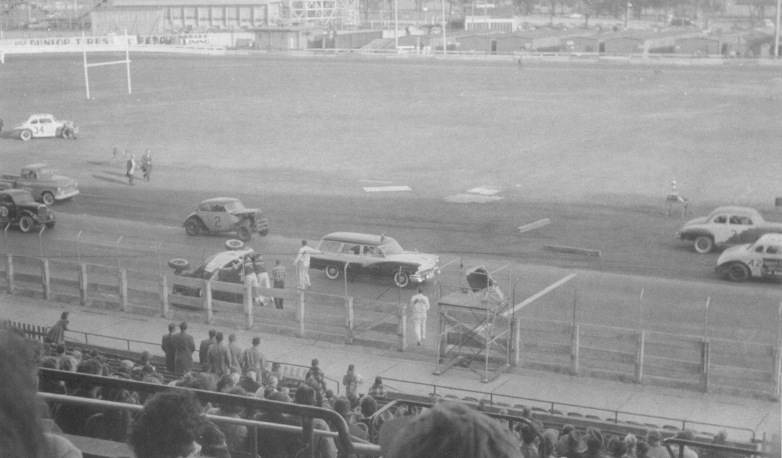
Photo courtesy of Pamela Stec
The NASCAR Convertible Division made its only appearance at the CNE on July 6, 1956. The 150 lap feature was won by Don Oldenburg. Joe Weatherly was second and Tom Pistone was third.
Tragedy struck the CNE drivers during the break for the Exhibition when Ted Race, one of the top drivers, was killed in an auto accident.
The last points night of the 1956 was on October 5. The 75 lap Autumn Championship was the feature of the night and was won by Hugh Darragh. Ken Fisher was the points leader going into the night. In second place, and the only driver within reach, was Jim Wilson. Unfortunately for Wilson, he had to miss the last few nights due to an injury. Fisher only had to start the race in order to wrap up the championship. Fisher dominated the season winning nine features, including four straight, the first driver in CNE history to do so.
The Modified Division
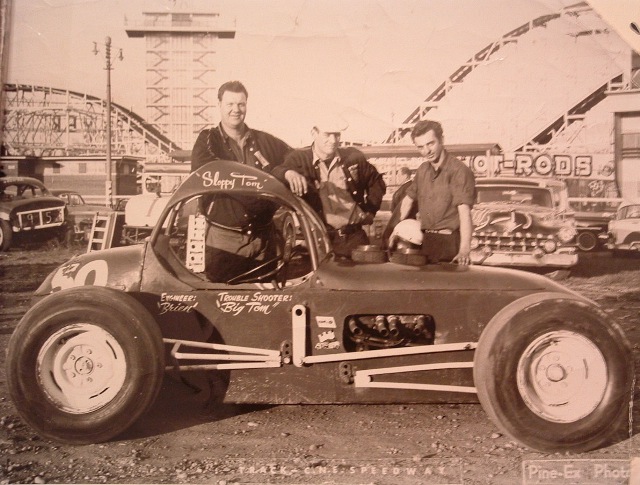
Photo courtesy of Tom Cuzzilla, Jr
Almost 14,000 fans greeted the racers on April 19 for 1957 season opener. The evolution of the cars was continuing at a fast pace. The Toronto Star reported that the cars were worth approximately $4500 (around $41,700 in 2020 dollars) and most had engines of 300 horsepower or more. Ted Hogan showed up with a Fiat-bodied car powered by a 325-horsepower engine.
The NASCAR Short Track Division returned on June 15, 1957. The lap feature was won by Jim Reed. Reed and Rex White had been battling for the lead on lap 99 when Reed knocked White out of the race. After the drop of the checkers, Reed admitted the mistake and offered the prize money to White.
The races on
June 28, 1957 made front page news in the Toronto Star. Ruth Carrier,
Miss Toronto 1951, was injured while driving in the Powder Puff
race. The news report said her foot stuck on the gas pedal and she
crashed through the fence. She was taken to the hospital unconscious
but returned to the track later that night with no injuries.
The Sprint Cars made their first-ever appearance at the CNE
Speedway on July 16, 1957. The 31 lap feature, cut down from 35 laps
due the races running late, was won by Leo Clum of Wapokenta, Ohio. Ted Hogan borrowed
a Sprint Car from a friend but it had no tires. He found front tires
for the Sprinter but could not find rear tires. He ended up using
the rear wheels and tires from his regular stock car. Since he was
also racing the stock car, his team spent the evening switching
the wheels between the two cars.
On Aug 2, 1957 the CNE Speedway hosted a 100 lap International.
Joy Fair won the race and $1200 in front of 17,402 fans. Ted Hogan
was the top Canadian finishing in 3rd in the race that featured
seven different leaders.
During the second
week of the Canadian National Exhibition, the track held a series
of afternoon races. These were non-points races.
Ted Hogan won
the 60 lap Autumn Championship to close-out the 1957 season. He
was also the points champion.
1958
The first big
event of the 1958 season was on June 20 when the Sprint Cars returned.
The newspapers did not report it, but it appears that this was an
IMCA event. Al "Cotton" Farmer of Fort Worth, Texas was the race winner. A teenage fan was slightly injured
at the end of the Sprint Car feature when he ran onto the track
and was hit by a car on its cool down lap. Fans had begun to do
this regularly at the end of the race program in order to get to
the pits. Normally the CNE stockers drove off the track immediately
but the Sprinters took an extra lap to slow down, surprising the
fans. The CNE officials made the decision to add a wire fence to
keep the fans back from the track.
NASCAR returned
on July 18, 1958 but instead of the Short Track Division as in years
past, this time it was the Grand National Division. Lee Petty won
the race that has been covered in more detail in another CanadianRacer.com
article.
The 1958 season wrapped up on August 2 with the 100 lap Canadian
International won by Jack Conely. It was the first time that the
CNE racers did not return after the Exhibition and this became the
pattern for the remaining seasons of the CNE's life. The 1958 season
was also the first time that the Amateur Division (or Hobby as it was
starting to be known as) was finally given a feature on a regular
basis. Jimmy Howard won the Modified points championship.
Throughout the
1958 season it appeared that the stock car racers would be given
the boot from Exhibition Stadium. The Argos had signed a deal to
use the stadium for their games beginning in 1959. Ernie Lieberman
was able to make a deal with the CNE to share the space with the
Argos. The track would be reconfigured into a quarter-mile with
the football field making up the infield. Work began on the new
track after the CNE closed in September.
CNE officials
spent $75,000 in reconfiguring the track to accommodate the football
field. The wooden fence was gone and replaced with steel guardrail.
The new track was narrower than the old third-mile configuration
- it was only 28 feet wide.
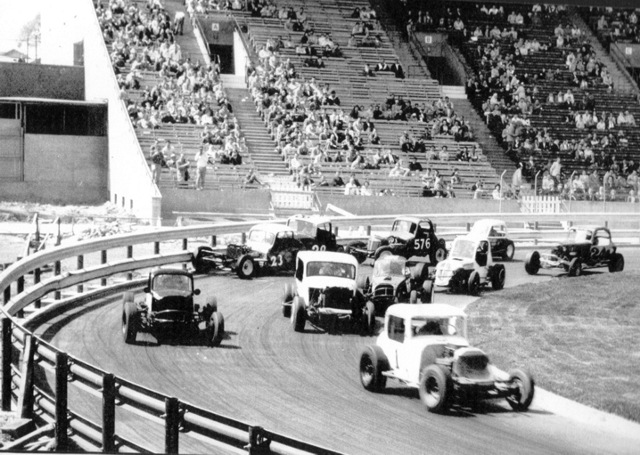
Photo courtesy of Canadian Motorsport Hall of Fame Archives
1959
May 1 was the opening day of the 1959 season. The drivers had a difficult time adjusting to the new track as there were multiple crashes in the early season. The program ran an hour late on the first night. Promoter Ernie Lieberman expressed his frustation to the Toronto Star, saying, "We're right back where we were eight years ago when we first opened. We've spent seven years ironing out the problems of the old style of racing." Ted Hogan's car burst into flames after he bounced off the guardrail. Hogan was taken to the hospital but only suffered cuts and bruises. Speedway officials were concerned about the length of the program, so in late May corners three and four (where most of the accidents were happening) were widened to 35 feet.
Some unexpected excitement came during warm-ups for the May 15 races when someone drove a street car onto the track. The unknown driver had been in the grandstand when his friend bet him he couldn't get his car on the track. Police were able to stop him after he had completed one lap. The driver won the bet, but was arrested and had his licence plates seized as the police declared his car unroadworthy.
Women had a chance to race on June 2 with a scheduled Powder Puff race. Carole Jackson, driving the Amateur class car of her husband Don, locked wheels with Laura Connelly, they slid into the infield and Jackson's car flipped end-over-end. She was removed unconcious from the car and taken to the hospital, uninjured. Ernie Liebermann announced that they would not run any Powder Puff races in the future because, "This is a man's track and from now on we'll confine the races to men. The women can watch from the grandstand."
Jimmy Howard won four features in the 1959 season on his way to the track championship. The season finished on June 30 with a 60 lap feature. It was the shortest season to date. The Toronto Argos took over the stadium beginning in July. This began a tradition at Pinecrest for the next few years that saw the CNE drivers racing there on Tuesday nights after the football season started. This brought drivers such at Ted Hogan, Don Fleming, Charlie Greenlaw, John Shirtliff, Howie Scannell, Jimmy Howard and the return of Norm Mackereth who had left Pinecrest to race at the CNE.
1960
In 1960, the CNE promoters finally received approval from Toronto City Council to allow Sunday afternoon racing. Various religous groups had opposed the idea. Some were quoted in the Toronto Star as saying the decision was "irresponsible and irreligious", that the stock cars were, "especially objectionable" and that Sunday was a "day of peace and quiet and people like that". The first Sunday event was on May 8, 1960.
In May the features were increased from 20 laps to 25. Ted Hogan had been pushing for the longer races to give the fast drivers, who started at the back of the field, a chance to make it to the front.
The yellow flag was introduced in 1960 along with the rule that puts cars involved in a caution to the back of the pack. Previously if a car crashed and was off the track surface, the races carried on. If the track was blocked, the race would be stopped and cars were put back in their previous positions.
Ted Hogan took advantage of the new re-start rule during the 50-lap Spring Championship. In order to save weight, Hogan was running a fuel tank that he knew did not hold enough fuel for the full 50 laps. During a caution, Hogan pulled up by the pit entrance. His crew ran out and dumped two gallons of gas in his tank. It made the difference as Hogan won the feature.
The NASCAR short track series was on the card for July 12, 1960. The feature was 100 laps and was won by Jim Reed. Buck Baker and Al White finished second and third.
The 100 lap International on July 22, 1960 was won by Jimmy Howard despite a scoring error that caused the race to last 112 laps. Howard had held the lead since lap 71 so the extra laps did not change the outcome. The win paid Howard $1100.
The 1960 season wrapped up on July 24 with Ted Hogan as points champion. The CNE drivers moved to Pinecrest on Tuesday nights and ran until August 30.
Tragedy hit the CNE Speedway community on November 23, 1960 when Ted Hogan and former racer Bruce Tanner died in a plane crash. The plane, owned and piloted by Hogan, was on its way to the Island Airport when it was seen to spin, catch fire and then crash into Lake Ontario.
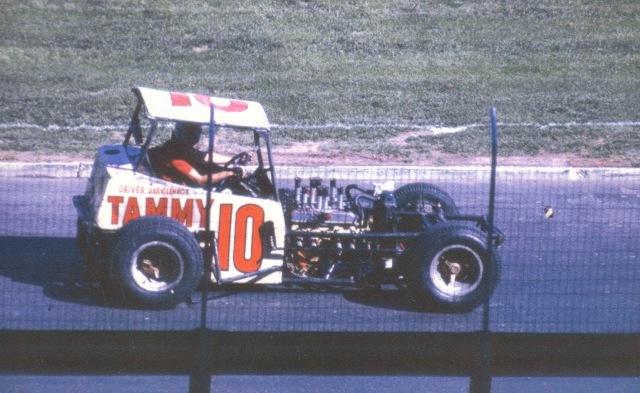
Photo courtesy of Canadian Motorsport Hall of Fame Archives
The 1961 season opened with forty-six Modifieds and sixty-five Hobby cars in the pits. After a few weeks, Glenn Schurr took over driving Hogan's car. Schurr took a few weeks to get the feel of the car and he picked up his first feature win on June 2.
Sprint Cars were added to the show on June 18, 1961. The 50 lap feature was won by Jim McElreath. Ken Fisher did double-duty, running his own car in the Modified races and also racing a Sprint Car. Fisher won the Sprint Car semi-final but dropped out of the feature.
July 4, 1961 was "Ted Hogan Memorial Night". About forty former CNE drivers were on hand for two Oldtimers races that were won by Jim Warren and Phil Major. The season was dominated by the driving team of Gary Witter and Jimmy Howard. Witter drove a Howard-built car to the 1961 points championship, just edging out Howard. The 1961 season closed out with a 100 lap International, won by Norm Mackereth.
1962
The 1962 season was the first time that the Hobby Division ran a feature every night. In past seasons, the Hobbies only ran a feature on an intermittant basis.
The United Racing Club Sprint Cars were on the calendar for June 1, 1962. The 30 lap feature was won by Earl Halaquist of Sydney, New York. Ted Tufford, one of the regular CNE Modified Division drivers, ran well in a Sprint Car but dropped out of the feature with a broken axle.
Harvey Lennox dominated the 1962 season on his way to winning the points championship. He also won the 100 lap International to finish the 1962 season.
1963
Howie Scannell arrived for the 1963 season with a former Indy Championship car that had been raced by Tony Bettenhausen. Glenn Schurr started off the season by winning the first three Modified features.
The USAC Midgets took over the CNE Speedway on April 26, 1963 for a 200 lap feature named the "The Toronto 500". The race was won by Elmer George (father of Tony George, later president of the Indianapolis Motor Speedway). The race featured several crashes. The drivers complained that the field of 33 cars was too large for such a small track.
The CNE Speedway experience a "first" on May 10, 1963 when the races were cancelled due to heavy rain and fog. Jack Greedy dominated the second-half of the 1963 season and wrapped up the points championship on the second-last night. Harvey Lennox closed out the 1963 season with a win in the 100 lap International.
During the Modified years the star drivers were Ted Hogan, Jimmy Howard, Don Fleming, Harvey Lennox, Jack Greedy, George Makins, Norm Mackereth, Jack McCutcheon and Glenn Schurr.
1964 - The Late Models Take Over
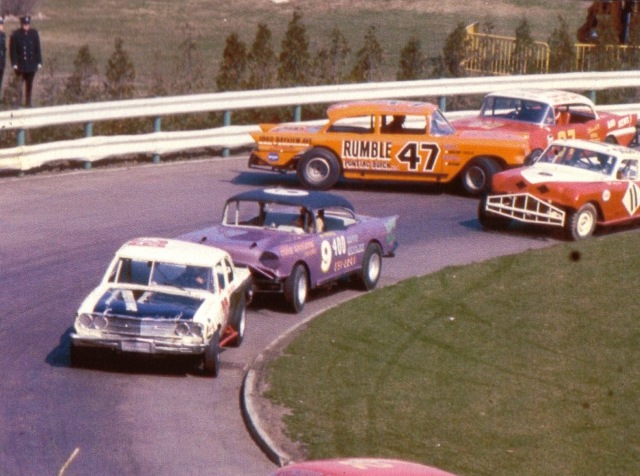
Photo courtesy of Canadian Motorsport Hall of Fame Archives
Opening day of the 1964 season was on March 27, the earliest the track had ever opened. The CNE always kicked off the new season on Good Friday, regardless of the date. The early start brought a cold wind off the lake with minus four degree temperatures. There were eighteen late models in the pits and The Toronto Star reported that twenty more were being built. Gerry Watson, driving a 1958 Ford, won the first late lodel feature of the season.
The USAC Midgets rolled into the CNE for the 2nd Annual "Toronto 500" (actually 200 laps). Officials learned their lesson from the 1963 race and only started 24 cars in the feature. The race was won by Ray Elliott of Joliett, Illinois. Eliott's car was powered by a Ford Falcon engine in a field of Offenhausers and won $1900. Second place went to Mike McGreevy of Hayward, California and third to Jimmy Knight of Worth, Illinois. CNE regular Jack Cook drove a car owned by Jim Davies. He did not make the feature but won the non-qualifiers' race.
The year was dominated by Jack Cook in the Late Models and Pat Duke in the Hobby Division. Both drivers won their respective points championships.
1965
The $800 claimer rule for the Late Models was dropped, thereby opening up the rules to more recent model cars. The bodies had to be 1957 or new, but 1956 bodies were allowed if they were in top condition.A new rule was put in place to limit engines to 335 cubic inches. Shoulder harnesses were mandated for the first time.
The Globe & Mail reported that the May 2 races had 32 Late Models in the pits, the largest number to that point.
The track was repaved after the opening event of the 1965 season. The USAC Midgets were back on June 9, 1965. The 100 lap feature, shortened from 200 laps in 1964, was won by Ronnie Duman of Dearborn, Michigan who picked up $605 for his efforts. Tom Selberg started from the pole and led the first 93 laps but brushed the wall and he lost a wheel, allowing Duman past. Mel Kenyon of Davenport, Iowa was second and third went to Tom Copp of Fresno, California. Mario Andretti was entered but did not make the field. Mike McGreevy set a new track record of 16.42 seconds.
Jack Cook continued his domination of the Late Model division, winning the championship for the second year in a row. John Clapham was the Hobby Champion. The 1965 season concluded with a 50 lapper won by Cook. The event also concluded starter Ross Kennedy's career at the CNE as he decided to devote more time to his business.
1966
The 1966 season was quiet by previous standards. The USAC Midgets did not return and the only special event was the season-ending 100 lapper (run in two 50-lap segments).
Norm Lelliott and Vic Parsons both won more features than Jack Cook but Cook repeated as Late Model Champion. Terry Dickinson won the Hobby Championship.
The End
In late 1966 the shocking news came out that stock car racing at the CNE was coming to an end. The track was to be replaced with a rubberized track for track-and-field events. It was not a complete surprise to promoter Ernie Lieberman though. Knowing that the end was coming, Lieberman was investigating the possibility of racing midgets indoors at The Coliseum during winter. Unfortunately, the track-and-field announcements also included The Coliseum.
It probably should not have come as a complete surprise to Toronto racing fans either. The number of race dates was dropping in the final few years. In addition, the number of special events was reduced each year until there were none in 1966. Finally, the crowds were not as large as they were in the earlier years.
The closing of the speedway led to the formation of the Ontario Amateur Racing Club (Vronos, Inc) better known as the Hobby Club and now as the Canadian Vintage Modifieds.
The CNE drivers were still not welcome at Pinecrest due to the feud between the two tracks' management and so the stars of the Late Model era: including Jack Cook, John Shirtliffe, Vic Parsons, Norm Lelliott, Ross Howes, Doug Warnes, Howie Scannell and others ended up scattered at the other tracks around Southern Ontario. Westgate Speedway, west of Peterborough, opened in 1967 and many drivers raced there on Sunday afternoons. Whatever feud may have existed between the CNE and Pinecrest must have been alleviated because some drivers ran there. Nilestown Speedway was another destination.
|
9Points Champions
|
